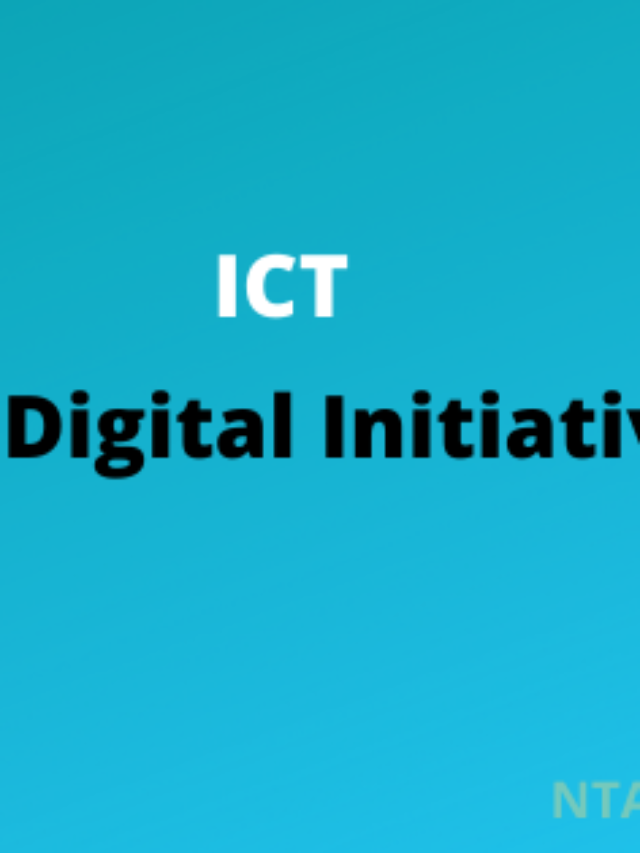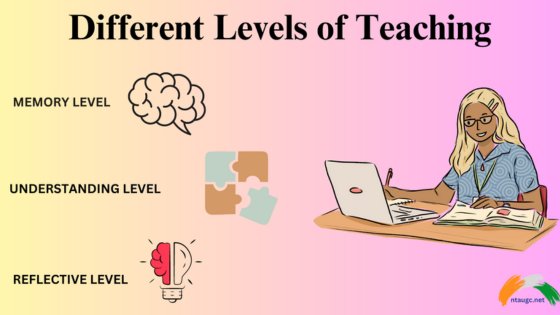In this post following topic of Teaching Aptitude will be covered
Teaching aptitude – Teaching: Concept, objectives, levels of teaching (memory, understanding and reflective), characteristics and basic requirements
Teaching aptitude
Teaching aptitude refers to the natural or acquired ability to teach and facilitate learning in others. It is a combination of various skills, abilities, and qualities that enable an individual to be an effective teacher.
A teacher with strong teaching aptitude has the ability to communicate ideas clearly, present information in an engaging and interactive way, and create a positive and supportive learning environment. They are also able to adapt their teaching methods to suit the needs and abilities of individual learners.
Other qualities associated with strong teaching aptitude include:
Strong subject knowledge:A teacher with strong teaching aptitude has a deep understanding of the subject they are teaching and is able to convey this knowledge to their students.Patience and empathy: Effective teachers understand that students learn at different paces and have different learning styles. They are patient and empathetic, and are able to create a supportive and inclusive learning environment for all students.Creativity and innovation: Teachers with strong teaching aptitude are able to develop creative and innovative teaching methods that keep students engaged and motivated to learn.Critical thinking and problem-solving skills: Effective teachers are able to think critically and solve problems, both in their own teaching practice and in helping their students to develop these skills.Continuous learning and improvement: Teachers with strong teaching aptitude are committed to continuous learning and professional development, and are always looking for ways to improve their own teaching practice.
Concept of Teaching
Teaching is the process of imparting knowledge, skills, and values to students or learners through a structured approach. The aim of teaching is to facilitate learning, which involves the acquisition of knowledge, skills, and attitudes that enable individuals to develop their full potential.
Effective teaching involves careful planning, preparation, and delivery of information in a way that is engaging, interactive, and relevant to learners’ needs and interests. Teachers must be knowledgeable about the subject matter they are teaching, as well as the principles of pedagogy and learning theory.
Teaching can take many different forms, including lectures, discussions, group work, demonstrations, and practical exercises. It can be delivered in various settings, including schools, universities, training centers, and online platforms.
In addition to imparting knowledge and skills, teaching also aims to develop students’ critical thinking skills, problem-solving abilities, and creativity. Effective teaching involves creating a positive and supportive learning environment that encourages students to ask questions, explore new ideas, and develop their own opinions and perspectives.
Teaching is a dynamic and evolving field, with new technologies, teaching methods, and approaches constantly emerging. Effective teachers must be committed to continuous learning and professional development to stay up-to-date with the latest developments in their field and provide the best possible learning experience for their students.
What is teaching or Teaching definition ? How it is different from other relative concepts like instructions, conditioning, training, and indoctrination.
Teaching is the process of imparting knowledge, skills, and values to students or learners through a structured approach. The aim of teaching is to facilitate learning, which involves the acquisition of knowledge, skills, and attitudes that enable individuals to develop their full potential.
Teaching is different from other related concepts like instructions, conditioning, training, and indoctrination in the following ways:
Instructions: Instructions are specific directions or orders given to individuals to perform a task. Unlike teaching, instructions are generally limited to a specific task or procedure and do not involve the imparting of broader knowledge or understanding.Conditioning: Conditioning is a process of learning in which an individual’s behavior is shaped through the use of rewards or punishments. Unlike teaching, conditioning focuses on changing an individual’s behavior rather than imparting knowledge or understanding.Training: Training is a process of preparing individuals for a specific job or task. Unlike teaching, training is generally focused on the acquisition of specific skills or knowledge related to a particular job or task.Indoctrination: Indoctrination is the process of teaching a specific set of beliefs or values to individuals, often with the aim of shaping their worldview or behavior. Unlike teaching, indoctrination is often associated with a particular ideology or belief system and is not necessarily focused on imparting broader knowledge or understanding.
what is the Meaning, purport, and significance of teaching
The meaning of teaching is the process of imparting knowledge, skills, and values to students or learners through a structured approach. The aim of teaching is to facilitate learning, which involves the acquisition of knowledge, skills, and attitudes that enable individuals to develop their full potential.
The purport of teaching is to prepare individuals to be responsible and productive members of society, to help them develop critical thinking skills, problem-solving abilities, and creativity, and to equip them with the knowledge and skills they need to succeed in their chosen field of work.
The significance of teaching is that it plays a vital role in shaping the future of individuals and society as a whole. Effective teaching can have a profound impact on the lives of learners, helping them to develop their intellectual and emotional potential and to achieve their goals and aspirations.
Teaching also has broader social and economic significance. A well-educated and skilled workforce is essential for economic growth and development, and effective teaching can help to ensure that individuals are equipped with the knowledge and skills they need to contribute to their communities and the wider society.
some well-known Teaching definition by educator and administrator
H C Morrison
H C Morrison was an American educator and administrator. He is best known for his work in educational administration and for developing educational policies and practices. Here is his definition of teaching:
“Teaching is the dynamic interaction between the teacher and the learner to achieve certain objectives, through the process of imparting knowledge, skills, and attitudes in a specific subject area, that promotes the growth and development of the learner.”
H C Morrison
This definition highlights the importance of the interaction between the teacher and the learner, as well as the importance of setting clear objectives and promoting growth and development in the learner. The definition also emphasizes the role of teaching in imparting knowledge, skills, and attitudes, which are essential for the intellectual, emotional, and social development of learners.
Jackson
One of the most well-known teaching definitions is by philosopher and educator John Dewey. However, there is also a teaching definition by another prominent scholar, Phil Jackson, who is known for his work in education and coaching.
Phil Jackson’s definition of teaching is:
“Teaching is not about imparting knowledge. It is about creating conditions for learning to happen. In other words, teaching is about creating a learning environment in which students are engaged, inspired, and challenged to discover and create knowledge for themselves.”
This definition emphasizes the importance of creating a supportive and engaging learning environment, where students are encouraged to take an active role in their own learning and to develop their own knowledge and understanding. It reflects the idea that teaching is not just about transmitting information, but also about creating opportunities for students to think critically, explore their own interests and perspectives, and develop their own unique insights and ideas.
J B Hough
J.B. Hough was an American educator who served as the president of Northwestern University. He defined teaching as follows:
“Teaching is the art of assisting young minds to grow, through the spirit of the teacher infusing itself into the life of the student, a process that in a true sense makes the teacher both student and teacher at once.”
According to Hough, teaching involves more than simply imparting knowledge or skills to students; it is a process of facilitating the growth and development of young minds. The teacher plays a critical role in this process by infusing their own spirit and energy into the lives of their students, creating a dynamic and engaging learning environment that fosters curiosity, creativity, and intellectual growth. In Hough’s view, teaching is not a one-way process, but rather a reciprocal relationship in which both the teacher and student are engaged in a continuous process of learning and growth.
N.L.Gage
N.L. Gage, an American educational psychologist, defined teaching as follows:
“Teaching is the arrangement of contingencies of reinforcement which make learning more efficient and effective.”
In this definition, Gage emphasized the importance of reinforcement, which is the process of strengthening a behavior by providing consequences that increase the likelihood of that behavior being repeated in the future. Gage believed that effective teaching involves creating an environment in which students receive clear and consistent feedback on their performance, and in which positive behaviors are reinforced while negative behaviors are discouraged.
Gage’s definition also highlights the importance of efficiency and effectiveness in teaching. By arranging contingencies of reinforcement, teachers can help students learn more quickly and effectively, and can create an environment in which students are motivated to learn and succeed.
The objective of Teaching
The objective of teaching is to facilitate learning, which is the process of acquiring knowledge, skills, and values that enable individuals to develop their full potential. The goal of teaching is to help students or learners understand and internalize new information, apply it in different contexts, and develop the ability to think critically and independently.
Here are some points that describe the objectives of teaching:
- Facilitate learning: The primary objective of teaching is to facilitate learning, which is the process of acquiring knowledge, skills, and values that enable individuals to develop their full potential.
- Impart knowledge: Teaching aims to impart knowledge and information to students or learners through a structured approach.
- Develop skills: Teaching also aims to help students develop the skills they need to apply their knowledge effectively in different contexts.
- Foster critical thinking: Effective teaching helps students to think critically, analyze information, and solve problems independently.
- Build character: Teaching aims to help students develop positive attitudes and values, such as curiosity, creativity, empathy, and resilience.
- Promote social and emotional development: Teaching also aims to promote social and emotional development, including communication, collaboration, and self-awareness.
- Prepare for future roles and responsibilities: Teaching helps students to prepare for future roles and responsibilities, such as employment, citizenship, and lifelong learning.
- Appreciate cultural diversity: Teaching aims to help students appreciate different perspectives and cultural diversity, and become responsible global citizens.
- Nurture curiosity and a love of learning: Good teaching fosters a curiosity and love of learning that will carry on throughout a student’s life.
- Encourage personal growth: Teaching also aims to encourage personal growth and self-awareness, helping students to become well-rounded, productive, and engaged members of society.
In addition to imparting knowledge and skills, the objectives of teaching may also include helping students to:
- Develop positive attitudes and values, such as curiosity, creativity, empathy, and resilience.
- Build social and emotional competencies, such as communication, collaboration, and self-awareness.
- Prepare for future roles and responsibilities, such as employment, citizenship, and lifelong learning.
- Appreciate different perspectives and cultural diversity, and become responsible global citizens.
Ultimately, the objective of teaching is to help individuals to become well-rounded, productive, and engaged members of society who can contribute to the betterment of themselves and the world around them.
Nature and characteristic of teaching
The nature and characteristics of teaching include the following:
Intentional: Teaching is a deliberate and intentional activity, designed to facilitate learning and promote the development of learners.Dynamic: Teaching is a dynamic process that requires ongoing adaptation to the needs and abilities of learners, as well as changes in the environment and content being taught.Interactive: Teaching involves interaction between the teacher and the learner, as well as among learners themselves, and is a social process.Contextual: Teaching takes place within a specific context, such as a classroom, online platform, or workplace, and is influenced by the characteristics of that context.Learner-centered: Effective teaching is learner-centered, meaning that it focuses on the needs, abilities, and interests of the learner, and aims to engage them in the learning process.Facilitative: Teaching is a facilitative process, where the teacher acts as a guide and facilitator of learning, rather than as a source of information.Creative: Good teaching involves creativity, as the teacher designs and adapts methods and materials to meet the needs of individual learners and promote their engagement.Feedback-driven: Teaching is a feedback-driven process, where the teacher provides feedback to learners to help them improve their understanding and skills.Reflective: Teaching is a reflective process, where the teacher continually evaluates their methods and practices, and makes changes to improve student outcomes.Personal: Teaching is a personal and interpersonal process, where the teacher establishes and nurtures relationships with learners, and creates a supportive and inclusive learning environment.
how Teaching is different from conditioning
Teaching and conditioning are different in the following ways:
- Intention: Teaching is an intentional process, whereas conditioning is often unintentional and can happen naturally through repeated experiences.
- Aim: Teaching is aimed at facilitating learning and development, while conditioning is aimed at influencing behavior and responses.
- Nature: Teaching involves a deliberate and conscious effort to impart knowledge or skills, while conditioning can be subconscious and happen through repeated exposure to stimuli.
- Flexibility: Teaching is often flexible, adaptable and can be adjusted to the individual needs of learners, while conditioning is typically rigid and less adaptable to individual differences.
- Voluntary participation: Teaching requires voluntary participation from the learner, while conditioning can be involuntary and happen without the learner’s awareness or participation.
- Goal: The goal of teaching is to enhance the learner’s understanding and skills, while conditioning aims to elicit specific behaviors or responses.
how Teaching is different from training
Teaching and training are related concepts but have some key differences. Here are some ways in which teaching is different from training:
Focus: Teaching focuses on providing knowledge and promoting understanding, while training focuses on developing specific skills and abilities.Purpose: The purpose of teaching is to promote intellectual and personal growth, while the purpose of training is to improve performance and achieve specific goals.Learning outcomes: Teaching aims to promote deep learning and understanding, while training aims to achieve specific learning outcomes or performance objectives.Process: Teaching often involves a more interactive and exploratory process, while training is often more structured and focused on practicing and applying specific skills.Content: Teaching often involves a wider range of topics and concepts, while training focuses on specific areas of knowledge or skills.Timing: Teaching often occurs over a longer period of time, while training is often more concentrated and focused on a specific period or event.Assessment: Teaching often involves ongoing formative assessments to monitor progress, while training often involves summative assessments to evaluate achievement of specific goals or objectives.
how Teaching is different from instruction
Teaching involves facilitating learning through a variety of methods, such as providing explanations, creating opportunities for student practice, and offering feedback. It focuses on helping students understand the underlying concepts and develop the skills needed to apply them.
Instruction, on the other hand, typically involves giving specific directions or steps to follow in order to complete a task or achieve a specific outcome. It may be more focused on conveying information or demonstrating a particular technique.
how Teaching is different from Indoctrination
Teaching aims to provide students with knowledge and skills to help them develop critical thinking, problem-solving, and decision-making abilities. It is based on presenting information and different perspectives, encouraging questioning, and allowing students to form their own opinions.
Indoctrination, on the other hand, involves a process of teaching someone to accept a particular set of beliefs or ideas without questioning or critical examination. It often involves a one-sided presentation of information and the suppression of alternative views. The aim of indoctrination is to influence beliefs and attitudes rather than to promote independent thinking and learning.
Levels of teaching
Levels of teaching: memory, understanding, and reflective
Memory Level of Teaching : This level of learning is focused on rote memorization and recall of information. It involves the acquisition and storage of knowledge in long-term memory without necessarily understanding the underlying concepts.
here are some key characteristics of the memory level of teaching:
Emphasis on rote memorization: The primary focus is on memorizing information through repetition, rather than understanding or application.Passive learning: The teacher is typically the main source of information, and the students are expected to absorb and recall the information provided to them.Basic skills and knowledge: The content covered is often foundational or fundamental, such as basic vocabulary, formulas, dates, or names.Assessment based on recall: Evaluation is typically focused on testing how much information students can remember and reproduce, rather than on deeper understanding or application.Limited critical thinking: There is little emphasis on analysis, evaluation, or synthesis of information, as the focus is on simply remembering and reproducing information.Memorization aids: Strategies such as mnemonics, acronyms, and visual aids may be used to help students remember information.
Understanding Level of Teaching : This level of learning is focused on comprehension and grasping the meaning behind the information. It involves the ability to explain and apply what has been learned, and to connect it with other knowledge.
here are some key characteristics of the understanding level of teaching:
- Emphasis on comprehension: The primary focus is on understanding the meaning and significance of the information presented, rather than just memorizing it.
- Active learning: Students are encouraged to engage with the material and make connections between different concepts, and are often expected to work collaboratively or independently to deepen their understanding.
- Complex and diverse content: The content covered is often more complex and varied than at the memory level, and may involve critical analysis, interpretation, or application of concepts.
- Assessment based on analysis and application: Evaluation is typically focused on assessing students’ ability to apply what they have learned to new situations, or to analyze and synthesize information to create new ideas.
- Higher-level thinking skills: Students are encouraged to think critically, ask questions, and develop their own ideas and perspectives on the material.
- Use of various teaching methods: Instruction may involve a range of teaching methods, such as discussion, problem-based learning, or project-based learning, to help students develop deeper understanding.
Reflective Level of Teaching : This level of learning is focused on critical thinking and analysis. It involves the ability to evaluate, critique, and create new ideas based on what has been learned. It also involves self-awareness, the ability to reflect on personal biases and assumptions, and the consideration of multiple perspectives.
here are some key characteristics of the reflective level of teaching:
Emphasis on critical thinking: The primary focus is on developing students’ ability to think critically, analyze information, and evaluate ideas.Self-directed learning: Students are encouraged to take responsibility for their own learning, and may be expected to engage in independent research, reflection, or analysis.Complex and diverse content: The content covered is often highly complex and may involve interdisciplinary perspectives, or draw on multiple sources of information.Assessment based on evaluation and synthesis: Evaluation is typically focused on assessing students’ ability to evaluate and synthesize information, and to create new ideas or perspectives based on what they have learned.
In, this post (Teaching Aptitude) we covered the following topic.
Teaching: Concept, Objectives, Levels of teaching (Memory, Understanding and Reflective), Characteristics and basic requirements.
Syllabus of Teaching Aptitude
Unit-I: Teaching Aptitude
- Teaching: Concept, objectives, levels of teaching (memory, understanding and reflective), characteristics and basic requirements
- Learner’s characteristics: Characteristics of adolescent and adult learners (academic, social, emotional and cognitive), individual differences
- Factors affecting teaching related to: Teacher, Learner, Support material, Instructional facilities, Learning environment and Institution
- Methods of teaching in higher learning institutions: Teacher-centred vs learner-centred methods; offline vs online methods (Swayam, Swayamprabha, MOOCs, etc.).
- Teaching support system: Traditional, modern and ICT based
- Evaluation systems: Elements and types of evaluation, evaluation in Choice Based Credit Systems in higher education, computer-based testing, innovations in evaluation systems












